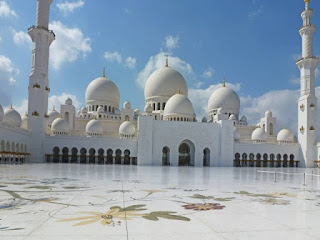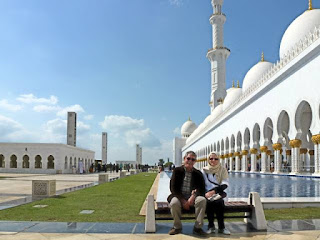We expected Dubai to be a modern, skyscraper city with a
huge range of manmade entertainments. It was all of that, with skydiving,
helicopter rides, desert safaris, artificial snow ski slope and so on,
including some things we’d never seen before like this steerable water-jet
platform. The man (or victim) is poised on the top like a stilt walker.
These activities are expensive, and your bank balance could
plummet as fast as a skydiver, but it doesn’t have to cost a fortune. Obviously
we were lucky in seeing sights with Rob that maybe not many tourists would have, but
they didn’t break the bank either. Other days we sat on the beach and swam in
the sea. It was warm, and clear as you can see.
The hotel provided sun loungers on the beach so we were able
to lie in comfort and watch the world- and the camels- go by.
The sun was hot even at this time of the year, but
comfortably so, around 25 degrees; even so, a few hours of direct sun was
enough and some afternoons we sat in the shady hotel garden. Again, they provided
comfy loungers. You’ll spot Jane, one of the loungers on the loungers.
The hotel itself was in a pedestrianised resort setting, kept
scrupulously clean, with the emphasis on family activities. There were street
entertainers every night and fireworks at the weekend, with a huge variety of
restaurants and cafes. Alcohol is very expensive, so no riotous behaviour was
observed; in fact, we felt completely safe in all the places we visited.
This is the hotel and immediate surroundings.
So Dubai had all the glitz we anticipated, but more besides:
some interesting, non-commercialised trips, and beach relaxation in pleasant
surroundings. In other words, we had an enjoyable time!





















